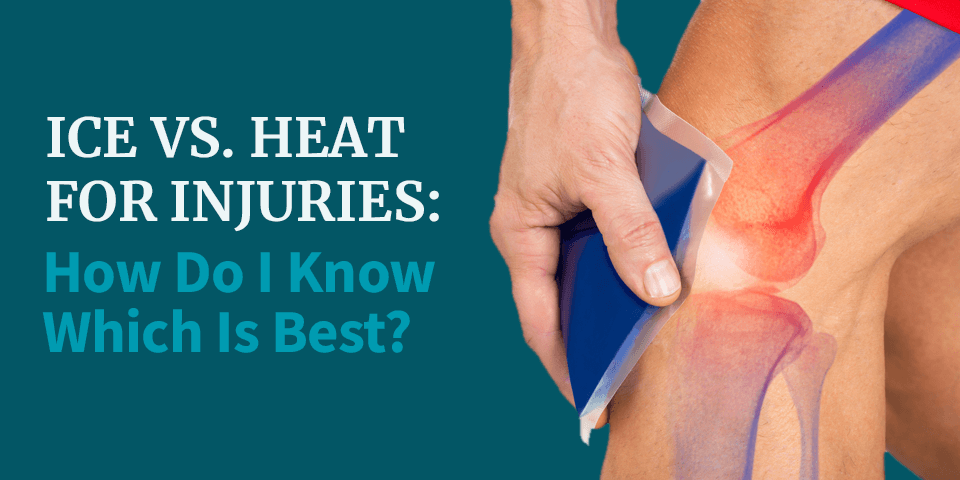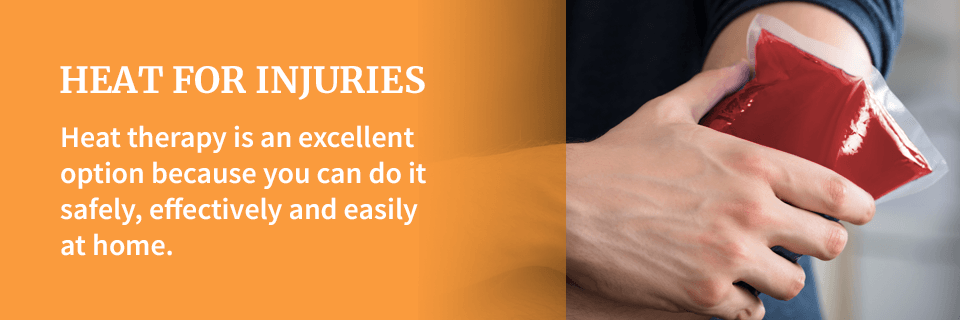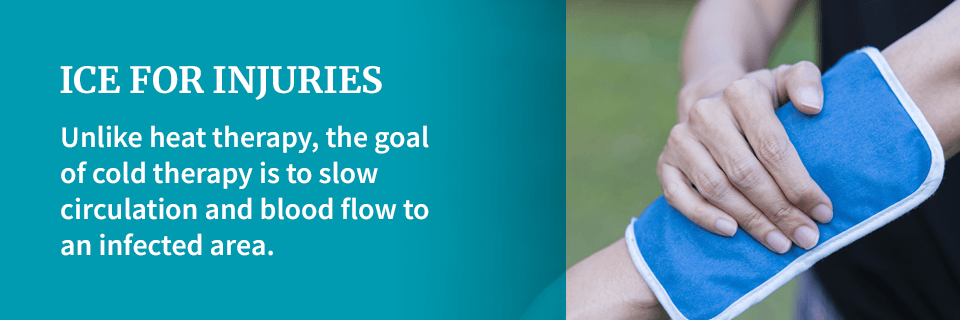
In this article:
What’s better for inflammation, heat, or ice?
Everyone experiences pain. Whether it’s a headache, a torn ligament, a sprained ankle or sore muscles, pain is just a fact of life for many people. Pain is our body’s way of telling us when something is wrong, whether it’s a new injury, a medical condition or the result of a long day on our feet. However, pain is not something anyone needs to tolerate.
Whatever the reason for pain, one undeniable fact remains: No one wants to be in pain. And, while modern medicine has produced a lot of reliable medications that are designed to help with various levels of pain, it’s not always necessary, or appropriate, to rely solely on medication to correct the problem.
That’s where ice and heat therapies come in. Depending on the source of your pain — arthritis, a new injury or a grueling workout — ice, heat or both can go a long way toward relieving your pain and improving the overall quality of your life.
Yes, we know most people are aware of this. And, if you’re like most people, you’ve likely got an ice pack stashed in your freezer and a heating pad tossed somewhere under your bathroom sink. But, do you know when to ice muscles vs heat them? Unfortunately, there is a lot of confusion out there over how to use them. Not only that, but if you choose wrong, you can make your problem worse, instead of better. Knowing how to use these two options for pain relief can go a long way in easing your pain and improving your comfort, whether you’re dealing with an injury or an ongoing chronic condition.
Heat for Injuries

While there’s no substitute for consulting with a doctor when pain occurs, having the knowledge to treat yourself can help you to stay more comfortable while you’re waiting for an appointment. Heat therapy is an excellent option because you can do it safely, effectively and easily at home.
The goal of heat therapy is to improve circulation and blood flow to raise the temperature around a specific area that has been injured or is experiencing pain of some kind. By increasing the temperature and improving circulation, heat can relax injured muscles, heal damaged tissues and improve flexibility.
Not only can heat calm pain flare-ups, but it is an excellent way to soothe muscle tension, stiffness and even chronic back pain. Muscle tension can spiral into many other problems, including headaches, which also cause pain. Relying on heat to relax your muscles can also relieve a lot of pain caused by stress and anxiety, in addition to chronic conditions or injuries. There’s a reason so many people swear by a relaxing hot bath or a stint in a sauna to improve their overall health and well-being.
How to Use Heat
You can administer heat therapy in two different forms: dry heat or moist heat. Dry heat is the kind that comes from heating pads or saunas, while moist heat comes from sources like steam towels or a hot bath or shower. Typically, when you’re using either form of heat therapy, you’ll only apply it to the specific part of your body that is in pain. The exception to this, obviously, is a hot shower or sauna, which tend to target your whole body. Of the two options, moist heat works faster, which means you won’t have to apply it as long as you would a dry heat. However, it can be messier, so it may not always be the best option.
As an aside, there are many different kinds of heating pads out there. If you opt to use an electric one, just make sure you don’t fall asleep while it’s on, or select one that has an automatic shutoff feature instead of remaining on until you switch it off.
When to Use Heat
Because the goal of heat therapy is to soothe and heal damaged tissues, it’s best to use heat when you are dealing with muscle pain or soreness. Doctors often recommend it to treat chronic muscle pain rather than a new injury — we’ll explain more about why later on. That’s not to say putting heat on an injury is out of the question — however, never apply heat to a new injury that is still swelling. Heat will make the swelling and pain worse, which is not what you want. You also should not apply heat if your body is already hot — for example, if you’re sweating. It won’t be effective.
One of the benefits of heat therapy is that you can apply it for longer than you can use ice. For minor aches and muscle tension, apply heat for 15 to 20 minutes at a time. If you’re treating more severe or widespread pain, longer heat sessions — such as a bath or sauna — may last from 30 minutes up to two hours.
We’ve said it before and we’ll say it again: Heat is an excellent way to ease pain and relax muscles. However, if you find yourself relying on heat over a long period without decreases in your pain levels, consult with your doctor. Heat is a good tool, but it’s not a substitute for necessary medical intervention.
One question many people have is whether it’s safe for pregnant women to use heat therapy. Because doctors advise against the use of hot tubs and saunas while pregnant, some people are worried even using a heating pad could be dangerous for women who are expecting a baby. That is because there are concerns over raising a pregnant woman’s body temperature and how it can affect the baby.
However, localized heat therapy is an excellent way for women to cope with the muscle aches and pains they experience during pregnancy, especially low back pain and muscle spasms. It doesn’t significantly raise a person’s core temperature, and there is absolutely nothing wrong with using a heating pad or moist towel to ease the inevitable pain that accompanies your increasing abdomen. Pregnant women should never apply heat directly to their abdomens, and, as we mentioned previously, pregnant women should always avoid full-body heat therapy like saunas or hot tubs.
Ice for Injuries

Unlike heat therapy, the goal of cold therapy is to slow circulation and blood flow to an infected area. It can reduce swelling and inflammation from an acute injury — that is, an injury that just happened — which in turn decreases pain and discomfort. That is because the cold also temporarily reduces the nerve activity around the affected area. Ice can also be an excellent option for someone who works out a lot, because an intense workout can cause swelling and pain.
How to Use Ice
Most of the time, ice therapy comes in one of four forms:
- Ice massage
- Ice packs
- Ice baths
- Coolant spray
In more extreme cases, your doctor may recommend using a cold therapy chamber, cryostretching or cryokinetics. But, you’ll typically need to do those activities under the observation of a medical professional, not on your own. For our discussion, we’re going to focus on the most common forms of ice therapy you can do in the comfort of your home.
Apply a cold pack directly to an affected area for a localized impact. Sometimes, you may need to use ice on a wider area or even your whole body — this is where an ice bath or massage may come in.
If you have wondered why ice hurts on your injury, you are probably making this common mistake. When you’re applying ice locally, make sure to wrap your ice pack in a towel. It should never directly touch your skin because the cold will hurt you. Unlike heat, you should only apply ice for short periods, though you can space out your sessions several times a day. In general, doctors recommend using ice therapy for 10 to 15 minutes at a time. Elevating the area you injured can also improve results. You can use a medical ice pack or, if one isn’t on hand, you can improvise with a bag of frozen vegetables or a plastic bag full of ice.
When to Use Ice
If you’re wondering, “Should I ice my injury?” here’s some additional advice. It’s best to use ice when an injury first happens, especially if you experience bruising and swelling at the site of your injury. Because it slows blood flow and circulation, ice can reduce bruising and swelling, which helps with pain and healing. Medical professionals don’t typically recommend ice for chronic muscle pain, although, as we’ll talk about later, there are exceptions to this rule.
Unlike heat, however, ice is not for everyone. It can cause some serious problems if people use it too much or incorrectly. People who have a sensory disorder that might prevent them from sensing pain shouldn’t use ice therapy without a doctor’s supervision. That’s because they may not be able to feel it if they leave the ice on their skin for too long, and then it may damage their skin. People who have cardiovascular disease, heart disease or issues with poor circulation should also avoid using ice therapy if they haven’t consulted with their doctor first.
Ice can also make your pain worse if you misuse it. For example, if your body is already cold, it will interfere with your ability to get warm, and it will also not effectively control and reduce your pain. Ice can also make your pain worse if you mistakenly use it to treat a tight muscle because it will make the muscle tighten and contract more, rather than relaxing it and easing the tightness that’s causing the pain. Sometimes this happens when people incorrectly identify the source of their pain. For example, this is common in people who struggle with pain in their neck or low back. They mistakenly apply ice to the affected areas, causing their muscles to tighten and spasm more instead of relaxing their muscles, which is what heat would do.
Should I Use Ice or Heat? How to Choose
Ice or heat: Which is better for an injury? We could fill pages with all the different scenarios where you might have to decide whether to use heat or ice to treat pain. But, as a general rule of thumb, we recommend this: If it’s bleeding or swelling, start with ice.
Depending on the extent of the injury, you may also want to go ahead and call your doctor. But, if you opt to wait, use ice for 48 hours. Then, if it’s still swollen and painful, definitely make a doctor’s appointment. This rule holds true even if you suspect you have injured a muscle.
What’s better for inflammation, heat, or ice?
Some other common questions are if heat can help heal a pulled muscle, or how long you should apply heat to the injury. While heat may be beneficial in the long term to heal the pulled muscle itself, ice may initially be the best treatment for the injury to reduce inflammation and the pain it causes.
If you’re sore or achy, start by applying localized heat to the area that’s bothering you.
Pay close attention to how your body reacts to the application of heat. Does your pain go away with a heating pad? If it doesn’t go away or the pain gets worse, stop using heat and call your doctor to set up an appointment to discuss the cause of your pain. Even if the heating pad does ease your pain, keep a close eye on how often you use heat to control your pain. If it becomes something you rely on a lot, you may still want to talk with a doctor about what’s causing your ongoing pain.

Sometimes doctors recommend alternating between ice and heat therapy, which is called “contrasting therapy.” One instance where this is a common recommendation is in patients with arthritis. Heat therapy can ease the joint stiffness that accompanies arthritis, while ice can treat swelling or acute pain that presents itself. Over time, someone who is suffering from arthritis may learn how to use both therapies to ease their pain, but only after consulting with a doctor.
We’ve said it before, but it’s worth repeating: Never use ice or heat therapy as an alternative to consulting with a doctor. Whenever you experience a significant injury or ongoing pain, it’s crucial to consult with a doctor you trust.
When Ice or Heat Isn’t Enough
If you have been injured or are experiencing chronic pain, it is essential to see a doctor, not only to discuss pain management, but to properly identify and treat the source of your pain.
Sometimes people try to avoid going to the doctor when they are in pain because they have had a bad experience. They may have been misdiagnosed or misunderstood. They may have seen a doctor who didn’t take the time to answer your questions. Or sometimes people are just afraid of what a doctor will find. At the Orthopedic Institute of Pennsylvania, our priority is compassionate and caring service. Our job is not to be right — our job is to identify the source of your pain and assist you on the journey to addressing and treating your pain. Pain should never become a lifestyle.
Based in Central Pennsylvania, we are proud to be a part of several medical partnerships that provide care and treatment to the residents in and around our service area. If you are experiencing pain, whether it began recently or has been ongoing for some time, contact us today and find out how the Orthopedic Institute of Pennsylvania can help you recapture a pain-free life.



